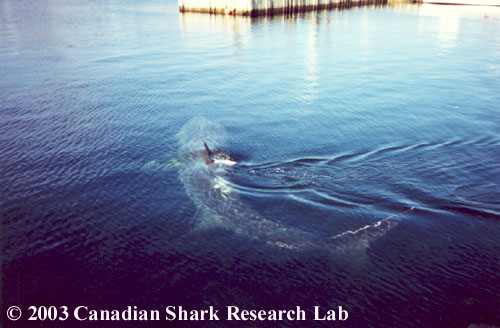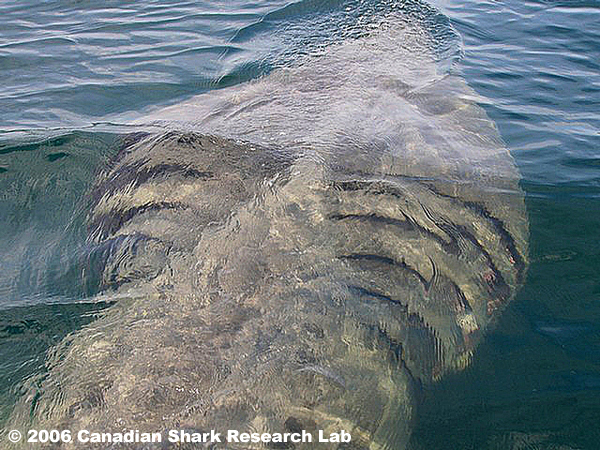Basking Shark
Description
The basking shark is the second largest fish in the world, second only to another filter feeder, the whale shark. It has a conical snout and the gill slits extend almost completely around the top and bottom of its head. Associated with the gills are structures called gill rakers. These gill rakers are dark in colour and bristlelike and are used to catch plankton as water filters through the mouth and over the gills. The basking shark is usually grayish-brown in colour and often seems to have a mottled appearence. The caudal (tail) fin has a strong lateral keel and a crescent shape. The teeth in the basking shark are very small and numerous and often number one hundred per row. The teeth themselves have a single conical cusp, are curved backwards and are the same on both the upper and lower jaws.
Range
The basking shark ranges throughout the north and south Atlantic Ocean, the Mediterranean Sea, north and south Pacific Ocean, the Sea of Japan, off southern Australia and around New Zealand.
In Canadian waters the basking shark is often seen during the summer and fall (May to September) near and around the coastline. It ranges from White Bay and Notre Dame Bay Newfoundland, to the Gulf of St. Lawrence, on the Scotian Shelf, along the Nova Scotia coastline, in the Bay of Fundy and south towards the U.S. border.
Habitat
The basking shark is a pelagic animal, occurring in both coastal and oceanic waters from 200 to 2000 m deep, but often straying inshore. It is commonly seen very near the surface of the water along the coast of Nova Scotia and New Brunswick in the spring and summer months. In offshore areas, it is often found near oceanic fronts at temperatures between 7 - 16 degrees Celcius.
Life History
The smallest free swimming basking shark caught was 165 cm. The basking shark can attain lengths of at least 10 meters, but the average size is 7-9 meters and may live up to 50 years. It is a highly migratory species. Although its seasonal movements are not well known, these animals may migrate to southerly waters during the winter. One basking shark satellite-tagged in Europe swam across the Atlantic to Newfoundland waters. They may occur in either small schools or alone. Small schools in the Bay of Fundy and Emerald Basin have been seen swimming nose to tail in circles in what may be a form of mating behaviour. Populations are often segregated by sex and size.
Diet
Basking sharks are planktonic feeders. By swimming with their mouths wide open, they filter plankton and small crustaceans out of the water with their long, tightly set gill rakers. The water then exits the body via the gill slits. Most of the plankton which is ingested consists of copepods and other crustaceans, fish eggs and larvae.
Reproduction
Not much is known about the reproductive biology of the basking shark. They are believed to be ovoviviparous, giving birth to live pups during the summer after a gestation period of 2-3 years. The young are generally 1.5 to 1.7 meters (5 to 5.6 feet) long. Males mature when they are between 4.6-6.1 metres in length. Females may reach sexual maturity at a comparable length and about 18 years of age, but no one knows for sure. Pregnant females are seldom encountered (one report in 1776) suggesting that they may separate themselves from other individuals observed by man.
Interaction with People
The basking shark is often killed by boats and entangled in nets in the same manner as whales, and is considered endangered in some parts of the world. In Atlantic Canada, the current population is estimated to be around 10,000 animals. A first assessment of basking shark stock status in Atlantic Canada is now available, both as a basking shark summary report and a full basking shark research document. Historically the basking shark was harvested for its liver, which yields large amounts of oil used in oil lamps and as a machine lubricant. A single shark can yield 200-400 gallons of oil. In parts of western Canada in the 1950's, it was considered a nuisance to fishermen; an eradication program to eliminate basking sharks involved fitting a Fisheries vessel with a sharpened ram on the bow to impale and kill basking sharks. Although this activity ceased many years ago, it decimated the basking shark numbers in the Canadian Pacific, and the population has still not recovered to this day. Basking sharks in the Canadian Pacific have been designated as endangered by COSEWIC; their status in the Atlantic is still being assessed.
Distinguishing Characteristics
- large gill slits and gill rakers
- teeth minute and numerous
- large conical snout
- often more than 6 metres long,
swimming slowly near surface

